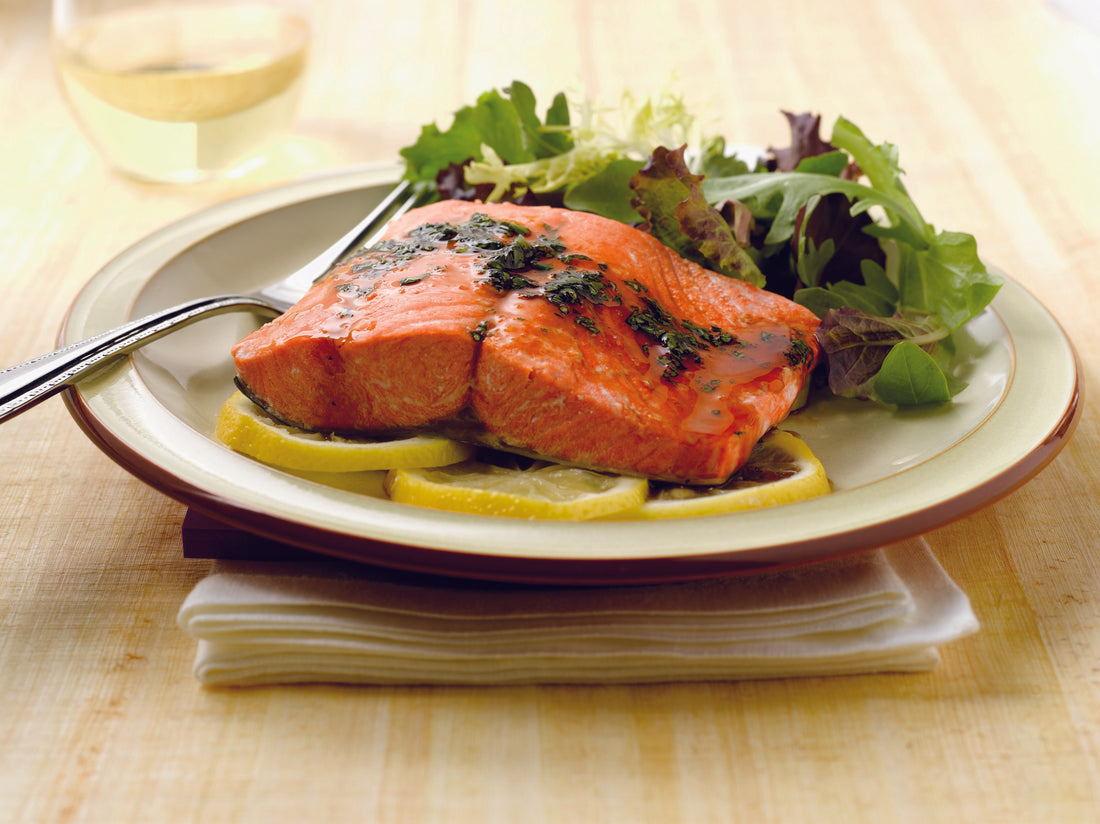
How to Steam Salmon
Why steam salmon?
Steaming salmon is quick and easy, avoids the use of unhealthy fats or oils, and yields perfectly cooked salmon that is moist and flavorful. Wild caught salmon, your best choice, is packed with protein and those all-important omega-3’s, so you just couldn’t choose anything healthier to serve than steamed salmon.
Steaming is a great cooking method that preserves a food’s natural flavor. Steaming wild salmon gently cooks the fish, producing delicious, moist, tender servings.
Directions for how to steam salmon
You will start with a filet of salmon, or perhaps you already have cut portions. Either works fine. Lightly sprinkle with salt and set aside.
A bamboo steamer is a convenient way to steam your fish. It imparts a gentle natural essence from the wood itself, and accommodates three different layers for the fish and any accompanying vegetables. A stainless steel steamer basket set in a large pan also works well. You could even use a large fry pan and a cake rack. The important thing is that your fish doesn’t touch the liquid. Whatever you choose, be sure it has a tight-fitting lid so it can trap the steam.
Add Liquid
You have some choices now. What liquid do you have on hand that you’d like to steam your fish in? Water works just fine, but wines can add some intriguing flavors. In the video above, Chef Kim Sunee uses Txakolina, a white wine with fresh fruity and citrus tones, reminiscent of a light cider. It infuses the salmon with a wonderful flavor, and of course is delightful to drink along with your meal. (We also like saying, “chocolina!”) Other white wines such as Sauvignon Blanc work well with fish, as does vegetable broth.
Add just enough of your chosen liquid(s) to almost touch the bottom of your steamer. You don’t want it to touch the fish. (We’re not trying to poach the fish in liquid).
Spice it up with aromatics
Salmon is delicious on its own, but you can spice it up further by adding other ingredients to your liquid, depending on what flavors you like. Consider thyme or parsley leaves, garlic shavings or scallions. Or for something sweeter, you could try lemon or orange slices (including the peel), or ginger. If you're adventurous, you could add them all! Our two favorite combinations are wine and ginger, or broth and lemon juice.
How to prepare your wild salmon for steaming
Remove the salmon skin or keep it on?
Some people like to steam their fish with the skin on, and others remove it. We think the skin adds extra flavor and helps to keep the fish intact, so we leave it on. If you do decide to skin it, you’ll want to slide a sharp flat knife just beneath the skin, leaving as much of that healthy fat on the fish as possible. Of course, the skin can be easily removed after steaming.
Remove pin bones (if any)
Next, check for pin bones. (You won’t have to worry about this if you are eating The Popsie Fish Company’s Sockeye salmon; we’ve already removed the pin bones for you. But if you’ve caught it yourself, you will need to remove them.) You can feel the tiny bones as you run your finger down the middle of your filet. There are special fish bone tweezers for this purpose, but regular tweezers or a small, clean needle-nose plier can pluck those little bones out quickly and easily.
Cut your salmon filets into portions
Because you’d like to cook them all at the same time, it works best to cut them roughly the same size (Or buy pre-cut 6 oz. portions). But salmon are tapered - thicker at the head end than at the tail. Take the flatter pieces and fold them over onto themselves so all your pieces end up about the same thickness. That will help all the pieces cook evenly.
In the video, Chef Sunee demonstrates how to wrap each piece of wild salmon in a cabbage leaf. This will not only trap the steam, but will make a lovely presentation. (To make the cabbage leaves pliable for wrapping, you may want to steam them first, right in your steamer.)
You can also use parchment paper for individually wrapping each fish piece, or even cheesecloth. And you can steam your fish without wrapping it at all.
How long to steam salmon
Bring your liquid and any aromatics to a boil, then turn to simmer and place your fish on the steamer so that each piece has its own space. Put the lid on and turn down the temperature so the water isn’t boiling fiercely, but is just slowly roiling. Check after about five minutes. Your fish pieces should lose their transparency as they approach doneness. Remove before fully opaque, because their residual heat will tend to continue the cooking process a bit longer. On a meat thermometer, they should register about 120 ℉. Of course, you can eat your salmon as raw or as done as you like it, because it’s completely safe and palates differ.
If you want to create a sauce to pour over your steamed salmon, in a separate small pan you can add some of the wine or broth, a little sesame or olive oil, the shaved ginger and some lemon slices. Let that all simmer while the fish is steaming.
Serve your steamed salmon on a bed of greens, or some fluffy rice, and top with that aromatic sauce you just created.
The finishing touches
Now, for an easy finishing touch, heat a few tablespoons of sesame oil in a pan. Place your steamed fish on serving plates. At this point, Chef Sunee sprinkles more ginger, and some fresh basil and cilantro on each fish, and pours on a few drops of soy sauce. Finally, she drizzles hot sesame oil over all and listens to it sizzle!
There you have it. Simple and streamlined, or spiced and succulent. Steamed wild Alaska Sockeye salmon with ginger!
Delicious! Enjoy!
For another steaming demonstration, watch this video by renowned chef and restaurateur Tom Douglas.
